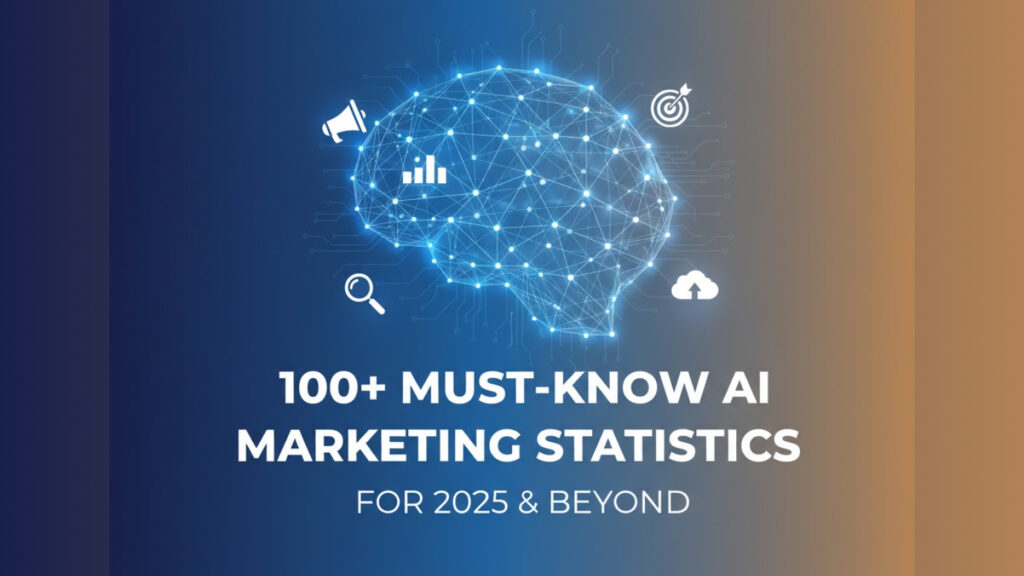
HOME / BLOG / STATISTICS
100+ AI Marketing Statistics for 2025: Trends, Benchmarks & Insights
- October 10, 2025
- Bill Nash
- 5:20 pm
Artificial intelligence is radically transforming how marketers research, create, optimize, and scale campaigns. But to navigate this fast-moving terrain, you need solid data—not just hype.
In this guide, you’ll find 100+ verified statistics about AI in marketing, sorted by domain (ad tech, content, personalization, SEO, automation, challenges, forecasts), along with expert analysis, trends to watch, actionable takeaways, and caveats. Use this as your 2025 AI marketing benchmark.
Table of Contents
Market Size & Growth
| Statistic | Value | Year / Source |
|---|---|---|
| AI in marketing (global market) | USD 47.32 billion in 2025 | per SEO.com SEO.com |
| Expected market value | USD 107.5+ billion by 2028 | CAGR ≈ 36.6% SEO.com |
| Generative AI market size | USD 62.75 billion in 2025; projected to USD 356.05 billion by 2030 | CAGR ~41.5% SEO.com |
| Contribution to global economy | AI (across sectors) expected to contribute USD 16 trillion+ by 2030 | from related reports (cited in SEO.com guides) SEO.com |
Analysis / Insight
The AI marketing space remains on a steep growth trajectory.
The generative AI segment is outpacing general AI adoption in marketing—especially in content applications.
The gap between “projected potential” and “current adoption” remains large, meaning there is room for late adopters to catch up.
Adoption & Usage by Marketers / Businesses
92% of businesses intend to invest in generative AI over the next 3 years
88% of digital marketers use AI in their day-to-day tasks
70% of marketers say their employer doesn’t provide generative AI training
According to SurveyMonkey:
56% of marketers say their company is actively implementing AI
32% have fully implemented AI; 43% are in experimentation phase
51% use AI to optimize content (SEO, email, etc.)
50% create content using AI
43% use AI to automate repetitive tasks
Insight
High intention to adopt, but actual adoption is still maturing.
There’s a skills / training gap—many marketers are left to self-teach AI use.
Content optimization and creation remain the early “low-hanging fruit” use cases.
Use Cases & Application Areas
Here are key AI marketing domains and stats around their usage:
| Use Case | % of Marketers / Businesses | Notes / Examples |
|---|---|---|
| Content optimization / SEO | 51% consider optimization a key use | includes keyword insertion, rewriting, metadata |
| AI-generated content | 50% use AI to create content | from blog posts to emails |
| Brainstorming / ideation | 45% use AI for idea generation | prompts, creative direction |
| Automation of repetitive tasks | 43% | e.g. data entry, tagging, social scheduling |
| Social media / monitoring | 43% think AI important for social strategy | sentiment analysis, topic tracking |
| Data analysis / insights | 41% use AI for analytics tasks | predictive modeling, clustering, forecasting |
Other domain-specific statistics (e.g. AI in SEO) include:
42% of businesses use AI to produce long-form website copy
84% of marketers believe aligning content with search intent via AI is important
35% of companies use AI to develop SEO strategies
Insight + Advice
Integration across functions (content + SEO + automation) is where real gains happen.
Use cases are strongest where scale, speed, or volume matter (e.g. multi-language content, personalization, real-time optimization).
Avoid overreliance—AI-generated output still needs human edit, brand voice, quality control.
Impact & Performance Gains
86% of SEO professionals have integrated AI into their strategy
67% believe generative AI helps automate repetitive tasks
65% of businesses have noticed better SEO results thanks to AI
52% of SEO professionals reported improved performance from AI-assisted on-page SEO
According to Taylor Scher SEO:
65% of businesses believe AI helps their SEO
67% see improved content quality via AI
68% get higher content marketing ROI using AI
Interpretation
AI adoption is translating into measurable improvements in many cases, especially for SEO and content marketing.
Gains are often incremental and depend on integration, oversight, and experimentation.
These stats support the claim that AI is not just “a fad” but a productivity multiplier when used wisely.
Challenges, Risks & Skepticism
Data bias / quality issues — AI models reflect biases in their training data; marketers need to audit and correct.
Lack of trust / hallucinations — AI outputs can include inaccuracies or invented facts; human review is essential.
Regulation & privacy — evolving AI / data regulation may restrict certain uses (personalization, profiling).
Skill & training gaps — many marketers lack formal training in AI tools (70% report no employer-provided AI training) SEO.com+1
Overhype & unrealistic expectations — some teams expect immediate breakthroughs; failure to set realistic KPIs can lead to disappointment.
Tool fragmentation / interoperability — many AI tools don’t integrate well, causing silos and complexity.
Forecasts & Trends to Watch
The AI marketing market will likely grow at a CAGR of ~35–40% through 2028.
Generative AI tools (LLMs) will continue to displace or augment traditional automation solutions.
We expect AI-native content creation + SEO stacks to dominate—tools that optimize, generate, and distribute content across channels autonomously.
Real-time personalization (micro-moments) will grow—AI systems will adapt messaging dynamically by channel/user moment.
Conversational AI + voice / visual search will amplify the need for semantic, entity-based SEO.
As Google’s AI Overview / SGE gains share, “citability” and structured signal (schema, data table, snippet readiness) will matter more.
The rise of Generative Engine Optimization (GEO) — optimizing content not just for search rankings, but for being cited in AI-generated summaries.
Note: A new academic paper “GEO: Generative Engine Optimization” outlines how content should be structured so that LLMs select your page as a source for responses. arXiv
Regional / Industry & Vertical Breakdowns
If you have access to proprietary data (e.g. from your own clients or region), include stats for Asia, SEA, Vietnam, etc.
Example: In B2B marketing, 75% of B2B marketers report using AI tools—content being the top area.
Compare adoption rates between sectors (e.g. ecommerce, SaaS, agencies).
Use maps or charts to show regional variance (e.g. North America vs Asia vs Europe).
Ready to Grow Your Business?
At Marketing LTB, we specialize in helping businesses like yours thrive online. From strategic digital marketing and branding to web development and social media management, we offer the tools and expertise to elevate your brand and drive real results.
Let’s build something amazing together, get in touch with us today!

About Marketing LTB
Marketing LTB is a full-service marketing agency offering over 50 specialized services across 100+ industries. Our seasoned team leverages data-driven strategies and a full-funnel approach to maximize your ROI and fuel business growth. Discover how our expertise can drive revenue for your business>

About the author, Bill Nash
Bill Nash is the CMO of Marketing LTB with over a decade of experience, he has driven growth for Fortune 500 companies and startups through data-driven campaigns and advanced marketing technologies. He has written over 400 pieces of content about marketing, covering topics like marketing tips, guides, AI in advertising, advanced PPC strategies, conversion optimization, and others.
